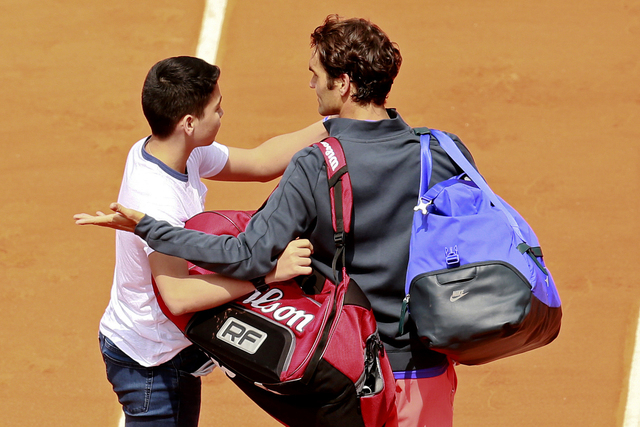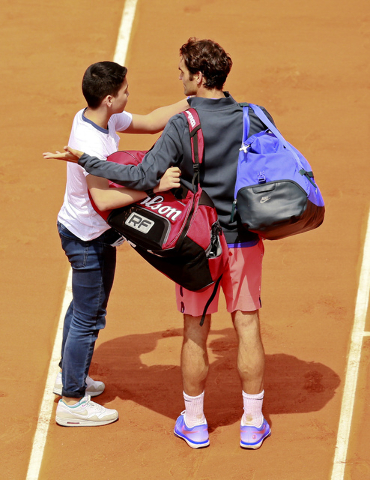Athletes must resort to selfie-defense
I suppose we can find some positive in the young man not carrying a selfie stick onto Court Philippe Chatrier, given the instrument has been perceived as the embodiment of narcissism.
And we know how much Parisians despise anyone who appears the least bit self-absorbed ...
But it didn’t make Roger Federer feel any safer Sunday, and it sure didn’t lessen the truth about how social media has brought fans closer to professional athletes than they probably should be.
The teenager who rushed Federer after his first-round victory at the French Open meant the champion tennis player no harm when requesting a selfie, but other such snapshots across the sports world have led to horrible endings and rightly suggested the security in charge of protecting athletes is often negligent.
Not that it’s always the fault of those paid to watch others.
Often, this stuff can’t be helped without totally ruining an event’s entertainment value.
In other words, they’re not about to erect a 50-foot high barbed-wire fence around the clay of Roland Garros, much less the nearest NBA court or major league baseball field.
No one is paying top dollar for that view.
We know athletes more personally now. We follow them on Twitter and Instagram. We know more about their family lives, their wives and children, their likes and dislikes away from competition.
We feel connected to them like never before, and it has made fans far more unabashed in their pursuit of landing a closer relationship.
It’s sort of like the person who has watched the same soap opera for decades, having long ago lost any sense of reality and is bitterly disappointed we all don’t believe people can be cloned and magically grow from infancy to adulthood in three episodes.
Many presume they own an intimate rapport with the actors and actresses on screen.
It’s no different now with fans and athletes.
I’m not sure those such as Federer are safer today than when tennis player Monica Seles was attacked by a knife-wielding madman in 1993. Things might be more dangerous now, even with advances in technology and bodies when comparing security details from then to 2015.
Fans are bolder in their actions, believing that the confidence born from sharing their opinions about an athlete across the Web and in turn learning more personal details about their favorite sports stars somehow affords them the right to impede on one’s workplace.
It puts the athlete in a frightening and uncomfortable position, because you never know if it’s just some kid who wants a picture or a father and son tandem running up behind Tom Gamboa in 2002 and attacking the then-Kansas City Royals first-base coach.
It’s all part of a money-driven train that can’t be slowed.
Owners can’t pay athletes enormous contracts if fans aren’t willing to pay excessive ticket prices, and those who can afford the best seats aren’t going to accept sitting far from the action. It all makes for open venues with countless areas from which many disturbed types have attacked.
I suppose you could hire more beefy sorts to wear yellow security jackets or train more German shepherds to patrol the outside of venues.
You can always wave more wands at purses and jackets.
But this reality isn’t changing: You can deter most fans with thoughts of trying to interact with athletes at inappropriate times, but will never totally stop all of those intent on making their way onto a playing surface.
So as the chances of something terrible again happening increase because of that brazen temperament of fans seeking selfies or autographs or actually wanting to harm those competing, here’s hoping they are treated more and more to the sort of physical welcoming an NFL linebacker might give a tackling dummy.
There should be no rules as to how far athletes can go in protecting themselves against these sort of unannounced attacks. Maybe someone is harmless and just wants a selfie. Maybe they’re not and are hiding a weapon.
It shouldn’t be on the athlete to determine how big a threat exists.
Federer would have been within his rights to respond by whacking the kid with a forehand to the head and asking questions later.
Social media has brought us closer and closer to athletes and action. Too close, perhaps. We know them like never before and, because of this, are bolder than ever before.
What happened Sunday at the French Open might have seemed like a mild occurrence, but it was a definite reminder of how vulnerable athletes remain. Federer had every right to be infuriated at how easily the young fan made his way to him as seemingly inattentive security guards daydreamed about their next baguette and cheese sandwich.
Scary thing, these selfies.
Las Vegas Review-Journal sports columnist Ed Graney can be reached at egraney@reviewjournal.com or 702-383-4618. He can be a heard on “Seat and Ed” on KRLV 1340 from 2 p.m. to 4 p.m. Monday through Friday. Follow him on Twitter: @edgraney.


















